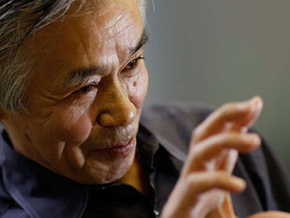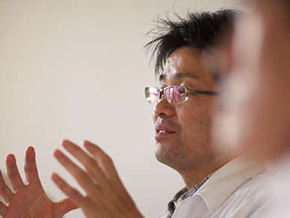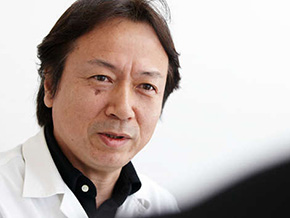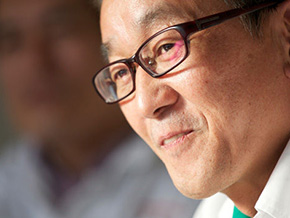Motorcycles Technology
CBR1000RR - History : Episode02
Racing technologies prove their value on the street
Racing technologies prove their value on the street
The year 2004 brought big changes to the CBR series. While the true home of the CBR900RR and its successors remained the street, the potential of these super sport bikes had come to the attention of competitive riders, who were beginning to ride CBR bikes more and more in races. Also, the Superbike World Championship changed its regulations to allow 4-cylinder engines up to 1,000cc in displacement. As a result, Honda decided to change its base motorcycle for Superbike from the VTR1000 with a V2 engine to a CBR bike with an inline 4-cylinder engine. The seventh-generation model would become the first in the series to be designed with racing as part of the equation. Thus, the engineers’ challenge was to create hardware that was completely at home on the street while also competitive in a racing environment.
At the same time, Honda’s 4-stroke 990cc RC211V racing motorcycle was sweeping away the competition in MotoGP, which is the highest class in the Road Racing World Championship Grand Prix, the premier championship of motorcycle road racing. Seeing the RC211V as the key to achieving success on both the street and circuit, the development team leveraged the advanced technologies of this racing machine in developing the CBR1000RR.

Seventh-generation 2004 CBR1000RR

New insights from a racing perspective
Former Honda Racing Corporation (HRC) works rider Hikaru Miyagi: Since the Superbike World Championship changed its allowed displacement to 1,000cc, Honda decided the seventh-generation 2004 CBR model would become the base vehicle for that competition. So displacement on the specification sheet went up, and the new model received numerous advanced technologies directly from the MotoGP racing machine. I saw it as a model that took on competitors in a frontal attack. The name of the bike changed to CBR1000RR, and it became a model that did not entirely fit the pattern established by its predecessors.
Final assembly team leader Kyoichi Yoshii: That’s right. When the Superbike World Championship changed its spec to four cylinders and 1,000cc, we designed the new CBR with this competition in mind. Among the development team members, however, there were those who said that CBR bikes were not intended for racing. And yet, up until that point, riders had used CBR bikes not only for getting around town and sporty riding but also for racing. Taking that into consideration and the fact that we’d be adopting cutting-edge technologies from our MotoGP racing machine, we felt that there would be some substantial merits to the new approach.
Miyagi: The RC211V was an incredibly easy bike to ride. For a racing bike, that is, but it really was amazingly easy to handle, and it was comfortable, too.
Kyoichi Yoshii: When we started developing the CBR1000RR, I had the opportunity to ride both the NSR500, which was for the old 500cc class, and the RC211V, which was for the new MotoGP class that replaced the 500cc class. When I took off on the NSR500, I had to slow down right away because of my level as a rider. If I didn’t stay focused, the front end would try to lift off the ground, and there was really no way to enjoy accelerating on the bike. On the RC211V, however, I was really surprised to find that I could keep giving it more throttle, just as if I were on a regular sport bike. What was even better was the incredible amount of control it offered. It reminded me of a particular scene from Grand Prix racing—when Kevin Schwantz on his Suzuki RGV500-Gamma accelerated into the spoon curve at Suzuka Circuit, making skid marks as he went. That scene floated up into my mind, and I felt as though I was about to recreate it. I wanted to deliver this same feeling to all of our customers. It really was this feeling of fulfilling a dream.

RC211V
Miyagi: There could be no greater source of inspiration than the RC211V, could there? The timing was really great for you to make all kinds of changes.
Yoshii: Whether you’re raising engine power or making other changes, you’ve got to adjust the entire body of the motorcycle to ensure total control. The RC211V provided us with the perfect image of how this is done. We had the chance to leverage this in a commercially produced vehicle and redesign the body, the engine and everything else. The other manufacturers were all offering 1,000cc super sport bikes of their own. So we thought that now was the perfect time to use our most advanced technologies and create a super sport bike in the Honda tradition on which riders could enjoy sporty riding with the highest level of enjoyment and peace of mind.

Racing technologies reach the street
The switch from 2-stroke to 4-stroke engines in MotoGP meant that the new bikes had vastly different characteristics from the old, such as higher vehicle weight and increased engine braking. In order to give riders total control over the new 4-stroke bikes, it was necessary for manufacturers to rethink their design completely. Honda responded by pursuing at the highest level the characteristic that is perhaps the essence of a racing motorcycle—concentrated mass—and designed the body of its new bike to counteract the rear wheel sliding caused by strong engine braking. One technology that was crucial in the implementation of this vision was the new Unit Pro-Link rear suspension.
Miyagi: We were talking about how Honda applied the technologies of the RC211V to the new CBR1000RR. The revolutionary Unit Pro-Link rear suspension was one such technology. As the person responsible for suspension design, what would you say were the merits of the Unit Pro-Link in the new model?
CBR1000RR suspension design team leader Masayuki Fujita: Technically speaking, it’s true that the Unit Pro-Link was a part of the suspension, but it had a more important effect than its role as a suspension part or swingarm.
Miyagi: What was the effect?

Fujita: If we’re talking about just the suspension, then using the Unit Pro-Link increases the weight of the swingarm and unsprung parts. But the benefit of the Unit Pro-Link was that the cushion unit didn’t need to be supported by the frame. This difference increased the freedom of frame rigidity, allowing us to create a design that prioritized rigidity in the pivot area of the frame.
Miyagi: I see. So we’re not talking about how just the suspension or frame works by itself but instead about a technology that has an effect on the entire finished vehicle. I guess that means that while you as the suspension designer had quite a tough time of it, the frame designers were extremely happy, right?
Fujita: Yes, without putting forth any effort, they got a more lightweight frame. [Laughs.] Even though the suspension gave us a tough time, the use of the Unit Pro-Link allowed the frame to be designed with a great deal more freedom. As a result, we were able to realize a higher level of turning performance and overall stability than ever before.
Fifth-generation CBR900RR (CBR929RR) Assistant LPL Kenji Hasegawa: In previous models, there was an upper cross-pipe to which the suspension was attached, but now the fuel tank could be positioned there, resulting in a greater concentration of mass and a more optimal moment of inertia.
Miyagi: This also connected with your goal of giving the 2000 and 2002 models a lighter riding feel without increasing rigidity. It’s true that the CBR1000RR was a bit heavier than its predecessors, but the greater freedom of frame design made possible a vehicle that had a lighter riding feel than one would expect from its weight.
Fujita: That’s correct.
Miyagi: In terms of new technologies on the CBR1000RR, the Honda Electronic Steering Damper (HESD) was fantastic. One day I borrowed the CBR1000RR used for PR at Honda’s Aoyama headquarters, and I got on the Metropolitan Expressway. This expressway has some rough patches, one has to look for gaps in the traffic flow in order to change lanes, and it just isn’t an easy road to ride on by any standard. I was really surprised that, even on this expressway, the CBR1000RR was so easy to ride that it didn’t feel like riding a high-powered super sport bike at all.
Seventh-generation CBR1000RR Large Project Leader (LPL) Hirofumi Fukunaga: It really makes me happy to hear you say that. We really wanted riders to be able to ride in any environment with peace of mind. And I was really proud that we were able to present the CBR1000RR as the most stable super sport bike in the world at high speeds and in the rain, and that riders could ride it with such peace of mind.
"Just because it’s really cool"
Styling that promises sharp riding. A wild and aggressive face, like that of a beast stalking its prey. The center-up exhaust pipe, moved from its traditional position to inside the tail cowl. The world of elite racing not only provided insights that helped the development team enhance performance; it also helped them take the looks of their creation to the next level. Deeply inspired by the RC211V, the CBR1000RR introduced riders to an entirely new world of style.
Former Honda Racing Corporation (HRC) works rider Hikaru Miyagi: The CBR1000RR was the first in the series to feature the center-up exhaust pipe located in the tail cowl. This must have been tough to design, since you had to move a heavy part away from the center of the bike and also put it up high. What was your reason for adopting this feature?
Seventh-generation CBR1000RR Large Project Leader (LPL) Hirofumi Fukunaga: Just because it’s really cool!
Miyagi: That’s great. That’s what I wanted to hear! In the 2008 model, the exhaust pipe returned to the traditional side position, and I was rather sad about it. [Laughs.]
Ninth-generation CBR1000RR designer Toshiaki Kishi: Of course, from an engineering perspective, there were all kinds of merits and demerits to the center-up layout, and it seemed that people looking at it from other perspectives were having a debate as well. From both a functional and styling perspective, I thought it was about time to do something about this huge muffler protruding from the side of the most cutting-edge super sport bike of the era, and so I wanted to move it to the interior of the body. In terms of styling, this feature was extremely well received. I also think it was extremely exciting for riders that their favorite bike really captured the innovative image of the RC211V, which was winning race after race in MotoGP.


Miyagi: The center-up muffler was certainly stylish, but it had to have a lot of insulation around it, didn’t it? This has really stuck in my memory. The exhaust pipe is something that can get really hot, and since it’s located up high, you had to make sure that people couldn’t get burned. Even as you were struggling to make the whole machine light one gram at a time, you worked hard to ensure safety, which really made me feel Honda’s dedication in this area.
Final assembly team leader Kyoichi Yoshii: Our intention is to keep riders, owners and their families happy. With the performance of super sport bikes always going up, riders have come to be seen as these extreme people. But that’s not what we were going for at all. Our goal was to have more people understand motorcycles and have riders ride with greater enjoyment and safety.
Miyagi: Even though the tail cowl was so thin, you pulled off the huge feat of including a small storage compartment. Unlike the 900cc era bikes, there was no hinge, and there was only enough room for a U-lock, but I could sense you really wanted to include this feature.
Kishi: This feature of course was part of the roots of the CBR series, indicating that, from the beginning, the home of these bikes was on the street. Frankly speaking, when I was working on the clay model, I felt like just getting rid of it. [Laughs.]
Hasegawa: The center-up muffler had also several big benefits when it came to the motorcycle body as a whole. It contributed to an optimal left-right center of gravity offset, as well as to the bike’s aerodynamic characteristics. This may sound obvious, but it wasn’t just for looks. The person responsible for engine development said, “This thing is here just to look cool, and it has no real merit,” but he was able to use the longer exhaust pipe to good effect, and when we put the muffler down on the side again for the ninth-generation model, he complained that it was better when the exhaust pipe was longer. [Laughs.]

An inline-4 for an out-of-the-ordinary experience
From single-cylinder to horizontally opposed 6-cylinder configurations, Honda offers a wide variety of powerplants in its motorcycle lineup. For its racing bikes as well, Honda makes V2, V4 and V5 and numerous other types of engines that have produced exceptional results on the track. Among all these possibilities, the design team selected an inline 4-cylinder engine for the CBR1000RR with specific objectives in mind.
Miyagi: The design of the seventh-generation CBR1000RR was greatly influenced by racing. At the time, one thing I wondered was why you didn’t bring a racing engine to the street, which would be a V4 in the case of the current RC213V.
Fukunaga: A V4 could make a super sport bike enjoyable to ride on the street, but we felt an inline-4 was our best option.
Hasegawa: An inline-4 is absolutely the best choice when it comes to the freedom of the body layout, which is essential to our goal of giving as many riders as possible a highly enjoyable riding experience. I’m very confident of this, since we’ve considered all kinds of options over the years.
Yoshii: What’s interesting about a bike with an inline-4 is that, when you get on and ride, you really have an experience that’s out of the ordinary. It’s the exact opposite of everything being unchanging and the same and ordinary. It doesn’t matter if you’re going slow, or riding with the throttle half-open or totally opening it up—an inline-4 responds to all these different scenes with a completely different character. Riding at 80 km/h gives you one type of riding feel, and then when you accelerate up to 100 km/h, you get a totally different type of riding feel. In contrast, a V4 feels as though it’s always giving you the same amount of torque, and though it does feel powerful, you don’t get a real feeling of speed from the engine itself.

Miyagi: Right, I understand what you mean. I clearly recall how, after the 1985 Suzuka 8 Hours Endurance Road Race, I borrowed an RVF750 from the Rothmans Honda team and took it for a spin. As compared to what I had been regularly riding, an air-cooled inline 4-cylinder Moriwaki CBX750F, I felt as though I could not slow down enough on the 130R turn on the Suzuka Circuit. The RVF750 with its V4 engine just produced much more speed than I expected. So I think a V4 has a role to play in a world-class 300 km/h race, and I think it can also be good in a tourer when you’re going a long distance in one go. But for enjoyable, sporty riding on the street, I think an inline-4 is the best.
Fukunaga: Yes, that matches our thinking exactly. That’s why we went with an inline-4 engine.
CBR1000RR - History

Episode 00 : Challenging the supremacy of engine power

Episode 01 : Lightweight design that transcends the spec sheet

Episode 02 : Racing technologies prove their value on the street

Episode 03 : Still shining bright―the origins of the CBR series

Episode 04 : Beyond ease of handling lies the joy of control